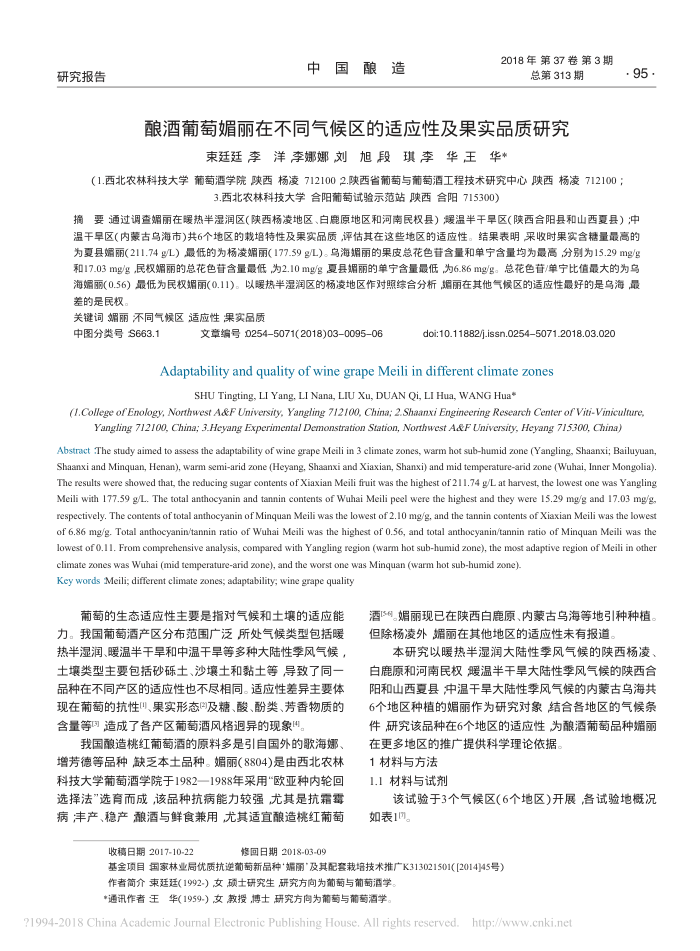酿酒葡萄媚丽在不同气候区的适应性及果实品质研究
内容简介
 研究报告
研究报告中国酿造
2018年第37卷第3期
总第313期
酿酒葡萄媚丽在不同气候区的适应性及果实品质研究
束廷廷李洋李娜娜刘旭段琪李华王华*
·95·
(1.西北农林科技大学葡萄酒学院陕西杨凌7121002.陕西省葡萄与葡萄酒工程技术研究中心陕西杨凌712100;
3.西北农林科技大学合阳葡萄试验示范站陕西合阳715300)
温干早区(内蒙古乌海市)共6个地区的栽培特性及果实品质评估其在这些地区的适应性。结果表明采收时果实含糖量最高的为夏县媚丽(211.74g/L)最低的为杨凌媚丽(177.59g/L)。乌海媚丽的果皮总花色苷含量和单宁含量均为最高分别为15.29mg/g 和17.03mg/g民权媚丽的总花色苷含量最低,为2.10mg/g夏县媚丽的单宁含量最低,为6.86mg/g。总花色苷/单宁比值最大的为乌海媚丽(0.56)最低为民权媚丽(0.11)。以暖热半湿润区的杨凌地区作对照综合分析娟丽在其他气候区的适应性最好的是乌海,最差的是民权,
关键词媚丽不同气候区适应性果实品质
中图分类号S663.1
文章编号:0254-5071(2018)03-0095-06
doi:10.11882/j.issn.02545071.2018.03.020
Adaptability and quality of wine grape Meili in different climate zones
SHU Tingting, LI Yang, LI Nana, LIU Xu, DUAN Qi, LI Hua, WANG Hua*
(1.College of'Enology, Northwest A&F University, Yangling 712/00, China; 2.Shaanxi Engineering Research Center of Viti-Viniculture,
Yangling 712J00, China; 3.Heyang Experimenta/ Demonstration Station, Northwest A&F University, Heyang 715300, China)
Abstract The study aimed to assess the adaptability of wine grape Meili in 3 climate zones, warm hot subhumid zone (Yangling, Shaanxi; Bailuyuan, Shaanxi and Minquan, Henan), warm semi-arid zone (Heyang, Shaanxi and Xiaxian, Shanxi) and mid temperature-arid zone (Wuhai, Inner Mongolia). The results were showed that, the reducing sugar contents of Xiaxian Meili fruit was the highest of 211.74 g/L at harvest, the lowest one was Yangling Meili with 177.59 g/L. The total anthocyanin and tannin contents of Wuhai Meili peel were the highest and they were 15.29 mg/g and 17.03 mg/g, respectively. The contents of total anthocyanin of Minquan Meili was the lowest of 2.10 mg/g, and the tannin contents of Xiaxian Meili was the lowest of 6.86 mg/g. Total anthocyanin/tannin ratio of Wuhai Meili was the highest of 0.56, and total anthocyanin/tannin ratio of Minquan Meili was the lowest of o.11. From comprehensive analysis, compared with Yangling region (warm hot sub-humid zone), the most adaptive region of Meili in other
climate zones was Wuhai (mid temperature-arid zone), and the worst one was Minquan (warm hot sub-humid zone). Key words Meili; different climate zones; adaptability; wine grape quality
葡萄的生态适应性主要是指对气候和土壤的适应能力。我国葡萄酒产区分布范围广泛所处气候类型包括暖热半湿润、暖温半干旱和中温干旱等多种大陆性季风气候土壤类型主要包括砂砾土、沙壤土和黏士等导致了同一品种在不同产区的适应性也不尽相同。适应性差异主要体现在葡萄的抗性"、果实形态及糖、酸、酚类、芳香物质的含量等间造成了各产区葡萄酒风格迥异的现象。
我国酿造桃红葡萄酒的原料多是引自国外的歌海娜、
增芳德等品种缺乏本土品种。媚丽(8804)是由西北农林科技大学葡萄酒学院于1982一1988年采用“欧亚种内轮回选择法”选育而成,该品种抗病能力较强尤其是抗霜霉病产、稳产酿酒与鲜食兼用尤其适宜酿造桃红葡萄
收稿日期2017-10-22
修回日期2018-03-09
酒。媚丽现已在陕西白鹿原、内蒙古乌海等地引种种植但除杨凌外媚丽在其他地区的适应性未有报道
本研究以暖热半湿润大陆性季风气候的陕西杨凌、白鹿原和河南民权暖温半干旱大陆性季风气候的陕西合阳和山西夏县中温干旱大陆性季风气候的内蒙古乌海共 6个地区种植的媚丽作为研究对象结合各地区的气候条件研究该品种在6个地区的适应性,为酿酒葡萄品种媚丽在更多地区的推广提供科学理论依据
1材料与方法 1.1材料与试剂
该试验于3个气候区(6个地区)开展各试验地概况如表13)。
基金项目国家林业局优质抗逆葡萄新品种'娟丽'及其配套栽培技术推广K313021501([2014]45号)
作者简介束廷廷(1992-)女硕士研究生研究方向为葡萄与葡萄酒学*通讯作者王华(1959-)女教授,博士研究方向为葡萄与葡萄酒学
?1994-2018 China Academic Journal Electronic Publishing House. All rights reserved.
http://ww.cnki.net